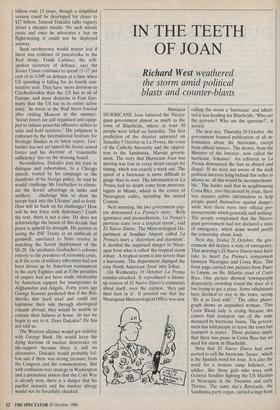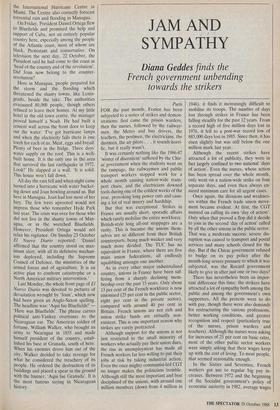IN THE TEETH OF JOAN
Richard West weathered the storm amid political blasts and counter-blasts
Managua HURRICANE Joan battered the Nicara- guan government almost as much as the town of Bluefields, where at least 50 people were killed on Saturday. The first prediction of the disaster appeared on Saturday 5 October in La Prensa, the voice of the Catholic hierarchy and the opposi- tion to the Sandinista, Marxist govern- ment. The story that Hurricane Joan was moving was true in every detail except for timing, which was exactly a week out. The speed of a hurricane is more difficult to gauge than its root. The information in La Prensa had no doubt come from meteoro- logists in Miami, which is the centre of Nicaraguan exiles, including the armed Contras.
Next morning, the two government pap- ers denounced La Prensa's story. 'With ignorance and premeditation, La Prensa's perverse scare over a tropical storm', said El Nuevo Diario. The Meteorological De- partment at Sandino Airport called La Prensa's story a 'distortion and alarmism'. It derided the supposed danger to Nicar- agua from what it called 'the tropical storm Johan'. A tropical storm is less severe than a hurricane. The department changed the cosy North American 'Joan' into Johan.
On Wednesday 19 October La Prensa counter-attacked. It reproduced a blown- up version of El Nuevo Diario's comments about itself, over the caption, 'they put their foot in it'. It pointed out that the Nicaraguan Meteorological Office was now
calling the storm a 'hurricane' and admit- ted it was heading for Bluefields. 'Who are the perverts? Who are the ignorant?', it jeered.
The next day, Thursday 20 October, the government banned publication of all in- formation about the hurricane, except from official sources. The decree, from the Minister' of the Interior, now called the hurricane 'Johanna'. An editorial in La Prensa denounced the ban as absurd and illegal: 'If we were not aware of the dark political interests lying behind this order to silence us, all this would be incomprehensi- ble.' The leader said that in neighbouring Costa Rica, also threatened by Joan, there was massive public information to help people guard themselves against danger, while here there were only official pro- nouncements which generally said nothing. The people complained that the .Nicara- guan government had not declared a state of emergency, which alone would justify the censorship about Joan.
Next day, Friday 21 October, the gov- ernment did declare a state of emergency. That morning's El Nuevo Diario must have take to heart La Prensa's comparison between Nicaragua and Costa Rica. The front page carried two pictures from Puer- to Limon, on the Atlantic coast of Costa Rica. One picture showed 'townspeople desperately crowding round the door of a bus trying to get a place. Some inhabitants have decided to stay in the town, saying "Be it as God wills".' The other photo- graph shows an anguished woman: 'This Costa Rican lady is crying because she cannot find transport out of . the zone menaced by hurricane Juana. The govern- ment has told people to leave the town but transport is scarce.' These pictures imply that there was panic in Costa Rica but no need for alarm in Bluefields.
Note that El Nuevo Diario had now started to call the hurricane 'Juana', which is the Spanish word for Joan. It is also the word for a woman camp follower, or soldier, like those girls who were with General Sandino fighting the US Marines in Nicaragua in the Twenties and early Thirties. The same day's Barricada, the Sandinista party organ, carried a map from
the International Hurricane Centre in Miami. The centre also correctly forecast torrential rain and flooding in Managua.
On Friday, President Daniel Ortega flew to Bluefields and promised the help and support of Cuba, not an entirely popular country here, especially among the people of the Atlantic coast, most of whom are black, Protestant and conservative. On television the next day, 22 October, the President said he had come to the coast as 'head of the country and of the revolution'. Did Joan now belong to the counter- revolution?
Here in Managua, people prepared for the storm and the flooding which threatened the shanty towns, like Lenin- grado, beside the lake. The authorities evacuated 80,000 people, though others refused to leave their homes. At my little hotel in the old town centre, the manager proved himself a Noah. He had built a cement wall across the front door to keep out the water: 'I've got hurricane lamps and when the electricity fails there is one torch for each of us. Meat, eggs and bread. Plenty of beer in the fridge. Three days' water supply on the roof. This is a well- built house. It is the only one in the area that survived the last earthquake in 1972. Look!' He slapped at a wall. 'It is solid. This house won't fall down.'
All day the rain fell and when night came turned into a hurricane with water bucket- ing down and Joan howling around us. But here in Managua, Joan had lost most of her fury. The few trees uprooted would not impress those who remember Hyde Park last year. The crisis was over for those who did not live in the shanty towns of Man- agua, or in the wretched Bluefields. However, President Ortega would not relax his vigilance. On Sunday 23 October El Nuevo Diario reported: 'Daniel affirmed that the country stood on max- imum alert, with all its defensive mechan- ism deployed, including the Supreme Council of Defence, the ministries of the armed forces and of agriculture. It is an active plan to confront catastrophe or a North American military intervention.'
Last Monday, the whole front page of El Nuevo Diario was devoted to pictures of devastation wrought by 'Joan', which now had been given an Anglo-Saxon spelling. The headline was: 'Aqui fue Bluefields!' 'Here was Bluefields'. The phrase carries political anti-Yankee overtones to the Nicaraguan ear. The American soldier of fortune, William Walker, who brought an army to Nicaragua in 1855 and made himself president of the country, estab- lished his base at Granada, south of here. When his enemies drove him out of the city, Walker decided to take revenge for what he considered the treachery of its people. He ordered the destruction of its buildings and placed a spear in the ground with the banner, 'Aqui fue Granada'. It is the most famous saying in Nicaraguan history.



























































 Previous page
Previous page